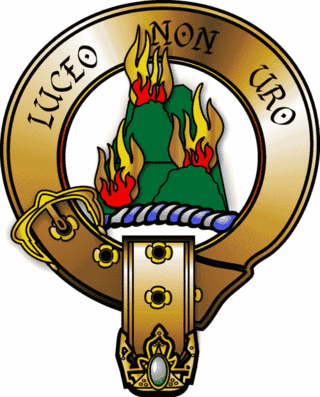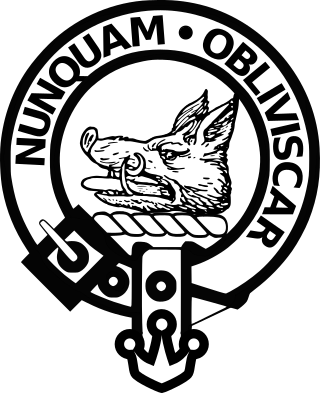
Clan Mackenzie is a Scottish clan, traditionally associated with Kintail and lands in Ross-shire in the Scottish Highlands. Traditional genealogies trace the ancestors of the Mackenzie chiefs to the 12th century. However, the earliest Mackenzie chief recorded by contemporary evidence is Alexander Mackenzie of Kintail who died some time after 1471. Traditionally, during the Wars of Scottish Independence, the Mackenzies supported Robert the Bruce, but feuded with the Earls of Ross in the latter part of the 14th century. During the 15th and 16th-centuries the Mackenzies feuded with the neighboring clans of Munro and MacDonald. In the 17th century the Mackenzie chief was made Earl of Seaforth in the peerage of Scotland. During the Scottish Civil War of the 17th century the Mackenzies largely supported the Royalists. During the Jacobite rising of 1715 the chief and clan of Mackenzie supported the Jacobite cause. However, during the Jacobite rising of 1745 the clan was divided with the chief, Kenneth Mackenzie, Lord Fortrose, supporting the British-Hanoverian Government and his relative, George Mackenzie, 3rd Earl of Cromartie, supporting the Jacobites.

The Clan Macrae is a Highland Scottish clan. The clan has no chief; it is therefore considered an armigerous clan.

Dingwall or Dingwell is a Scottish surname. One of the most prominent families by the name of Dingwall in Scotland were the Dingwalls of Kildun who were vassals of the Earl of Ross and also septs of the Clan Munro, a Scottish clan of the Scottish Highlands.

Castle Chanonry of Ross, also known as Seaforth Castle, was located in the town of Fortrose, to the north-east of Inverness, on the peninsula known as the Black Isle, Highland, Scotland. Nothing now remains of the castle. The castle was also known as Canonry or Chanonrie of Ross, the former county.
The Munros of Milntown were a family cadet branch of the Highland Clan Munro. As the earliest recorded cadet branch of the Munro chiefs, the Munros of Milntown were the 'senior' cadet branch of the clan, and spawned many cadet branches. They were frequently recorded as 'Monro' as well as Munro. The Munros of Milntown are notable for being involved in events concerning the history of the late Middle Ages in the Scottish Highlands.
Sir Robert Munro, 5th Baronet of Foulis was also 23rd Baron and 26th chief of the Clan Munro. He became blind and was known as the Blind Baron.

The Battle of Bealach nam Broig was fought between Scottish clans from the lands of north-west Ross, against north-eastern clans of Ross who supported the Earl of Ross. The actual date of the battle is debated, it probably occurred in 1452 but the Conflicts of the Clans suggests a date as early as 1299.

Clan MacIver or Clan MacIvor, also known as Clan Iver, is a Scottish clan recognised by the Lord Lyon King of Arms. The clan, however, does not have a chief recognised by the Lord Lyon King of Arms. Because of this the clan can be considered an armigerous clan. The clan name of MacIver is of Gaelic origin, derived from an Old Norse personal name. Various forms of the surname MacIver, like MacGiver, are considered sept names of several historically large Scottish clans, such as clans Campbell and Mackenzie. There exists a Clan Iver society in Fife, Scotland.

The Battle of Logiebride or Logie-Riach, also known as a Tumult in Ross was more of a small skirmish rather than an actual battle. The disturbance is said to have taken place on 4 February 1597 at the Logie Candlemas market near Conan House between men of the Clan Mackenzie against men of the Clan Munro and the Bain family of Tulloch Castle.
Robert Mor Munro, 15th Baron of Foulis, and 18th chief of the Clan Munro was a 16th-century Scottish chief. He was known as Robert Mor on account of his large stature. He was the eldest son of Robert Munro, 14th Baron of Foulis. Although this Robert Munro is traditionally 15th Baron and 18th overall chief of the clan, he is only the 8th Munro chief that can be proved by contemporary evidence.
Alexander Mackenzie, known as "Ionraic", traditionally counted as 6th of Kintail, was the first chief of the Clan Mackenzie of whom indisputable contemporary documentary evidence survives. During his long life, he greatly expanded his clan's territories and influence.
Fionnla Dubh mac Gillechriosd is purported to have been a 15th-century Scotsman, who lived in the north-west of Scotland. The Gaelic Fionnla Dubh mac Gillechriosd translates into English as "Fionnla the black, son of Gillechriosd". Fionnla Dubh is known from a late 17th-century traditional account of Clan Macrae; within that account he presented as a prominent ancestor of the clan. The tradition relates that for a time the chief of Clan Mackenzie was absent, and during that time his bastard uncles were causing trouble in the Mackenzies' territories of Kintail and Kinlochewe. Fionnla Dubh was then ordered to retrieve the chief and was successful in his task. From that time onward, says the tradition, the Macraes from the Kintail area rose in prominence amongst their Mackenzie lords. Tradition also states that Fionnla Dubh is an ancestor of the leading lines of the Macraes from Kintail.
George Munro of Foulis is traditionally the 10th Baron and 13th successive chief of the Clan Munro. However, he is only the third successive chief of the clan who can be proved by contemporary evidence. He was the eldest son of Hugh Munro, 9th Baron of Foulis and was seated at Foulis Castle.
Sir William Munro of Foulis was a Scottish Knight and Scottish clan chief of the highland Clan Munro. He is by tradition the 12th Baron of Foulis and 15th overall chief of the clan. However, he is actually only the 5th chief of the Clan Munro who can be proved by contemporary evidence.

The Skirmish of Alness was a conflict that took place in October 1715 in Alness, in the county of Ross in the Scottish Highlands. It was part of the Jacobite rising of 1715 and pitted Highlanders loyal to the British-Hanoverian Government of George I of Great Britain against Highlanders loyal to the Jacobite House of Stuart.

The siege of Brahan took place in Scotland in November 1715 and was part of the Jacobite rising of 1715. Highlanders loyal to the British-Hanoverian government of George I of Great Britain laid siege to Brahan Castle, seat of William Mackenzie, 5th Earl of Seaforth, who was a staunch Jacobite, loyal to the House of Stuart.
Hector Munro, 17th Baron of Foulis, also known as the master of Foulis, was a Scottish chief of the Highland, Scottish clan, Clan Munro. He is the 10th chief of Clan Munro who can be proved by contemporary evidence. He was seated at Foulis Castle.

The Battle of Drumchatt, or Druim-a-Chait, was a Scottish clan battle claimed by non-contemporary historians to have taken place in the year 1501 near Strathpeffer, in the Scottish Highlands. It was allegedly fought between the Clan Mackenzie and the Clan Munro. Mackenzie chronicles have claimed a signal victory.

The dispute over the lands of Beauly Priory took place in about 1577-78 in Beauly, Inverness-shire, Scottish Highlands. It was contested between Colin Cam Mackenzie, 11th of Kintail, chief of Clan Mackenzie and Thomas Fraser of Knockie who was the tutor to the young Simon Fraser, 6th Lord Lovat, chief of the Clan Fraser of Lovat. Fraser was supported by Robert Mor Munro, 15th Baron of Foulis.
Lachlan Mor Mackintosh, 16th of Mackintosh was the chief of the Clan Mackintosh, a Scottish clan of the Scottish Highlands. He was also chief of the confederation of clans that was known as the Clan Chattan.
13. "The History of the MacLennans" copyright, Ronald G. MacLennan of MacLennan, Clachan, Lochbroom, Ullapool 1978













